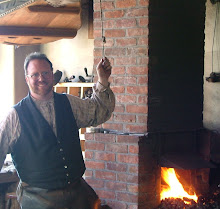Our Masterpiece Project from 2007 to the present (2010) is a long-term research project to rediscover the methods used to build an all iron and steel Scottish Pistol. The previous articles of the
Scottish Pistol Project discussed the history of the Pitcarn Pistol, it’s role in our Revolutionary War, and the first challenges of making our pistol.
After completing the stock, the next challenge was to forge-weld a barrel for the pistol from wrought iron. The raw material was
real wrought iron reclaimed from an old ox cart wheel's tire. Wrought iron forge-welds well at a high temperature, and is somewhat self-fluxing. The iron is taken to a high welding heat in the coal forge, fluxed, and then forge welded into a tube using the anvil and a swedge block. The logitudinal bending is started in a swage block or between the face and step of the anvil. About one hammer width is rolled at a time, trued up, and forge welded.
The wrought iron is welded into a tube with a small pilot hole down the center. After welding, a pass in the swage block helps to create a smooth, cylindrical barrel.
The next step is to turn the now round bar into a barrel. These pistols were smoothbore, so we don’t need to worry about rifling. The small pilot hole must be enlarged to make a finished bore. Our only “power tool” is a foot-treadle lathe. It isn’t able to generate the horsepower to drill out a .52 caliber bore. Instead we remove a small amount of metal at a time using reamers.
A succession of 6 or more reamers are used in the foot treadle lathe to turn the initial welded pilot hole into a round and true bore. This takes up to 45 minutes per pass and up to two days for the whole process. At the conclusion of the process the barrel has progressed from an irregular .30 caliber bore to reach our target bore diameter.
If there is no visible weld seam, the barrel may pass. A visible seam at this stage will condemn a barrel to display status. Here is one that failed inspection. Note the spiral line. That is not rifling, but rather is a flaw in the wrought iron. This barrel had internal flaws and slag inclusion in the iron. The only thing to do is to start over with another piece of iron and forge another barrel.
Here is the interior view of a barrel that passes inspection. Hurray!
Once a barrel has the desired interior bore, the work commences on the exterior! These pistol barrels are highly ornate. They are turned on the lathe to true the interior to the exterior. Then the round rings or “wedding bands” are turned. Much of the rest of the fluting, carving, and design is done with files and engraving chisels. It can take several days to complete the exterior of the barrel.
The next step is to carefully make the breech plug and to file the barrel to precisely fit into the forged stock. That has been done on the barrel above. Our next article on this project will discuss making the lock mechanism that will fire the pistol.













